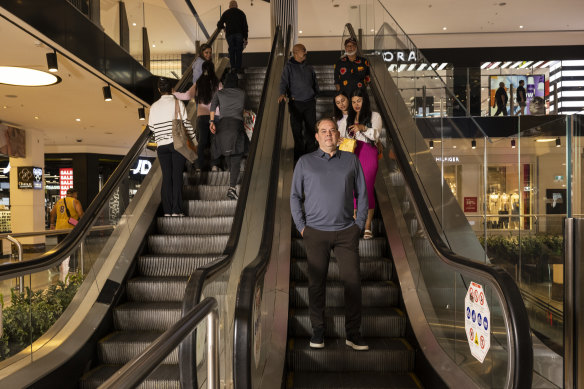This was published 6 months ago
Why shopping centre escalators are designed to make you get lost
By Julie Power
Have you ever caught an escalator up a floor or two at a shopping centre, only to be frustrated at being forced to circle past shops or merchandise you didn’t want or need before finding the next one up?
This is by design. “It is simply to make people get lost,” said David Gianotten, the managing partner/architect of the Dutch practice Office for Metropolitan Architecture (OMA), which has been exploring the power of retail.
There was “always an extra bank of escalators” to divert consumers from their goal so they “spend more money”, Gianotten said. The idea was to disorient shoppers and slow them down enough so they looked at the merchandise nearby, distracting them from their target.
He is working with the Powerhouse Museum on an unprecedented exhibition, set to open with the Powerhouse Parramatta in 2026, which will reveal the magic, tricks, and power of retailers that have transformed nearly every aspect of public life into a shopping trip.
He said OMA is conducting research on shopping and the role of the mall. This follows the practice’s research project with Harvard University students, Project on the City II: The Harvard Guide to Shopping.
Powerhouse chief executive Lisa Havilah said: “Arguably no other building type has more profoundly impacted the way we live than the shopping centre, and the exhibition will explore the psychology of them and how people, products, and capital flow through them.”

David Gianotten, the managing partner/architect of OMA at Westfield shopping centre in Parramatta.Credit: Louise Kennerley
Gianotten said retail and shopping were not well researched because exposing their secrets could risk the commercial model. The industry was “very careful to protect its Truman Show-like ideas” that it had shaped.
Even Victor Gruen, who pioneered shopping mall layouts that encouraged impulse buys, later regretted his invention. He called them “bastard developments” disfigured by “the ugliness and discomfort of the land-wasting seas of parking”.
The research guide found towns, trains, museums, art galleries, and sporting arenas had become shopping spaces. Consider “exit through the shop” signs at zoos, galleries and museums.
The Harvard shopping guide’s co-author and architect Sze Tsung Leong said: “Not only is shopping melting into everything, but everything is melting into shopping.”
Nothing, though, had revolutionised shopping and cemented the role of the mall as much as the invention of the escalator, say experts.
The escalator was patented in 1859 as moving stairs, making it effortless for customers to reach upstairs floors. When Harrods introduced them, sales staff gave customers free smelling salts.
In the late 1940s, a brochure from the Otis Company – which manufactures both the elevator and the escalator – said the elevator was ideal for the “man on a mission” who knew what he wanted, where it was located, and then bought it.
The escalator was designed for impulse buys, though.
In contrast to the elevator, Otis said the escalator “beckoned” a customer, its smooth continuous movement encouraging the casual shopper to take in the range of goods.
The world market for escalators was $94 billion in 2024, says Fortune Business Insights, and is expected to double over the next eight years.
Visiting Westfield Parramatta, which has 34 escalators plus lifts and travelators, Gianotten said public transport was increasingly located to facilitate shopping.
At Parramatta, an escalator deposits commuters from trains into the shops in seconds.
Like most malls, it was designed with anchor tenants at either end, small kiosks and pop-up shops were located in the middle of the “street” to emulate a village decorated with greenery, mostly fake.

Shoppers were so overwhelmed by the installation of the newfangled escalator at Harrods that smelling salts were provided. Credit: Getty Images
When he stood to have his photo taken near a pair of escalators, he noticed another set that went at right angles. “There’s always one set that is a little bit outside the circuit, so that [shoppers] feel, ‘Oh, where am I now?’ I’m disoriented,” he explained.
Gianotten says the Australian office of OMA is trying a new approach to the mall with the Wollert Neighbourhood Centre in Victoria.
Existing community centres were often underutilised. In contrast, the Wollert centre is a “shopping centre conceived as social infrastructure”.
It will be a “place for communal experience where retail and social interaction weigh equal”.
The 9000-square-metre centre will integrate community spaces – including a public courtyard, childcare and education facilities – with retail.
The exhibition will include objects from the Powerhouse collection, which includes an architectural model for Westfield Sydney, and others on loan from overseas.
The Morning Edition newsletter is our guide to the day’s most important and interesting stories, analysis and insights. Sign up here.